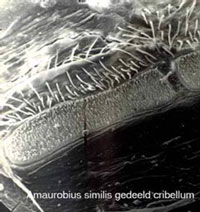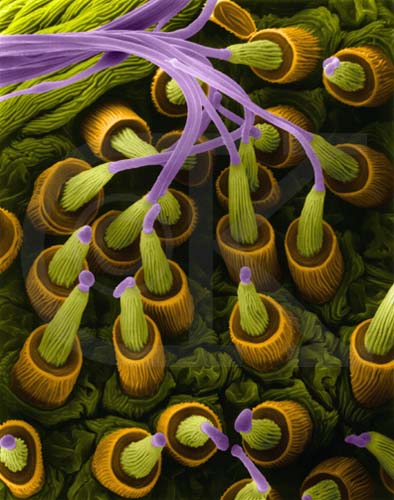|
Spiders produce up to seven different types of silk (although most produce less), and there is a different gland for each kind. The major ampullate gland forms the dragline silk and frame threads, while the minor ampullate gland produces silk that acts as dragline reinforcements; pyriform glands produce the attaching threads that attach dragline silk to other materials; aciniform glands produce silk for wrapping prey; tubiliform glands, also known as cylindrical glands, produce thread for the cocoons; flagelliform glands, also known as coronate glands produce silk for the cylindrical spiral of a spider web; aggregate glands form the sticky silk glue that goes on the cylindrical spiral; and lastly, the epigastric glands produce the so-called sperm silk. It should be noted that only the males produce the epigastric silk, and only the females produce the silk from the cylindrical glands.
|
 |
Cribellum of a spider.
Click to enlarge |
|
These glands are located within the abdomen of the spider and attach to moveable, hardened appendages known as the spinnerets, located just beneath the anus. The spinnerets open to the outside through numerous spigots. Each spinneret contains anywhere from 2-50+ spigots, and each spider has anywhere from 2-4 pairs of spinnerets. Only one genus, Liphistius, in the family Liphistidae of the suborder Mesothelae actually has the full complement of four pairs; most other species have three. In the species with three pairs, the area where the fourth should be contains one of two structures: either a nonfunctional disk, known as a colulus, or a flat plate known as the cribellum. Although the cribellum is not a spinneret, it does contain many minute spigots from which silk flows. A specialized structure located on the metatarsus known as the calamistrum, or comb, pulls the silk from the cribellum and combs it, giving it a characteristic wooly appearance.
The various silk glands attach to different spinnerets. The major ampullate and pyriform glands attach to the anterior spinnerets, the minor ampullate to the median, the cylindrical and aggregate glands to both the median and posterior, and the aggregate and flagelliform glands to the posterior. The epigastric silk comes from none of these, but rather is emitted from some spigots located in the epigastric region of the spider, underneath the abdomen between the book lungs. |
 |
Pyriform silk coming from spigots on anterior spinneret.
Click to enlarge |
|

 (1)
(1)  (2)
(2)